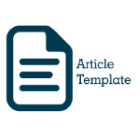Strategi Penyesuaian Akademik dalam kalangan Guru Pelatih OKU Penglihatan Di Sebuah Institut Pendidikan Guru
Abstract
Keywords
Full Text:
PDFReferences
Amatea, E., Smith-Adcock, S., & Villares, E. (2006). From family deficit to family strength: Viewing families' contributions to children's learning from a family resilience perspective. Professional School Counseling, 9 (3), 177-189.
Aspelmeier, J. E., Love, M. M., McGill, L. A., Elliott, A. N., & Pierce, T. W. (2012). Self-esteem, locus of control, college adjustment, and GPA among first- and continuing-generation students: A moderator model of generational status. Research in Higher Education, 53 (7), 755-781.
Credé, M., & Niehorster, S. (2011). Adjustment to college as measured by the student adaptation to college questionnaire: A quantitative review of its structure and relationships with correlates and consequences. Educational Psychology Review, 24 (1), 133-165.
Creswell, J. W. (2007). Qualitative inquiry and research design: Choosing among five approaches. SAGE.
Dwyer, A. L., & Cummings, A. L. (2001). Stress, self-efficacy, social support, and coping strategies in university students. Canadian Journal of Counseling, 35, 208-220.
Gurbuz, E., Hanley, M., & Riby, D. M. (2018). University students with autism: The social and academic experiences of University in the UK. Journal of Autism and Developmental Disorders, 49 (2), 617-631.
Jeyagowri, K., & Ilankumaran, M. (2018). The role of students in transition from school to college: Different challenges in elt. International Journal of Engineering & Technology, 7 (4.36), 630.
Kerr, S., Johnson, V. K., Gans, S. E., & Krumrine, J. (2004). Predicting adjustment during the transition to college: Alexithymia, perceived stress, and psychological symptoms. Journal of College Student Development, 45 (6), 593-611.
Hurtado, S., & Pryon, J. H. (2006). The American freshman: National Norms for fall 2005. Retrieved from, http://www.heri.ucla.edu/monographs/
TheAmericanFreshman2020.pdf.
Lackaye, T., Margalit, M., Ziv, O., & Ziman, T. (2006). Comparisons of Self-Efficacy, Mood, Effort, and Hope Between Students with Learning Disabilities and Their Non-LD-Matched Peers. Learning Disabilities Research & Practice, 21(2), 111–121. https://doi.org/10.1111/j.1540-5826.2006.00211.x.
Lapsley, D. K., & Edgerton, J. (2002). Separation-individuation, adult attachment style, and college adjustment. Journal of Counseling & Development, 80(4), 484-492.
Lowe, H., & Cook, A. (2003). Mind the gap: Are students prepared for higher education? Journal of Further and Higher Education, 27 (1), 53-76.
Muris, P. (2002). Relationships between self-efficacy and symptoms of anxiety disorders and depression in a normal adolescent sample. Personality and Individual Differences, 32 (2), 337-348.
Patton, M. Q. (1990). Qualitative evaluation and research methods. SAGE Publications.
Reichman, N.E., Corman, H. & Noonan, K. Impact of Child Disability on the Family. Matern Child Health J 12, 679–683 (2008).
Sevinc, S., & Gizir, C. A. (2014). Factors negatively affecting University adjustment from the views of first-year University students: The case of Mersin University. Educational Sciences: Theory & Practice.
Wintre, M. G., Dilouya, B., Pancer, S. M., Pratt, M. W., Birnie-Lefcovitch, S., Polivy, J., & Adams, G. (2011). Academic achievement in first-year university: Who maintains their high school average? Higher Education, 62 (4), 467-481.
Yamamoto, Y., & Holloway, S. D. (2010). Parental expectations and children's academic performance in sociocultural context. Educational Psychology Review, 22 (3), 189-214.
Copyright (c) 2024 Jurnal ILMI
This is an Open Access article distributed under the terms of the Creative Commons Attribution-NonCommercial-NoDerivatives 4.0 International (CC BY-NC-ND 4.0), permitting copy and redistribute the material in any medium or format.


